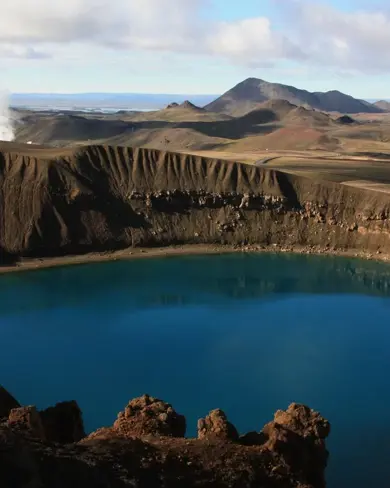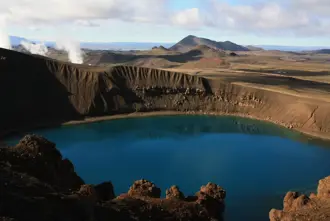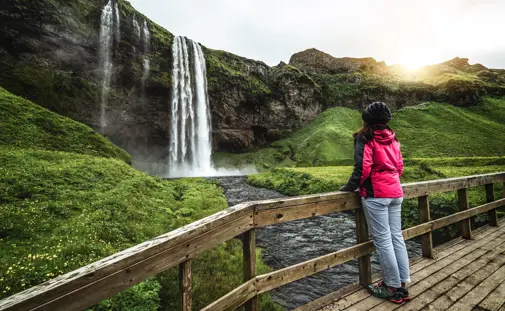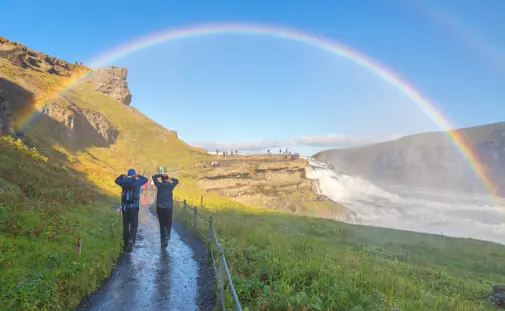Krafla Volcano, located in the Mývatn region of North Iceland, is one of Iceland’s most active and well-known volcanoes. Its 10 km-wide caldera, formed about 100,000 years ago, is part of the active volcanic zone along the Mid-Atlantic Ridge. Krafla is famous for its frequent eruptions, geothermal activity, and dramatic lava fields. Visitors to the area are captivated by its rugged landscape, which features craters, steaming vents, bubbling mud pots, and lava fields. The last major eruptions, known as the "Krafla Fires," lasted from 1975 to 1984, leaving behind a landscape that looks otherworldly and is still warm in places.
Krafla Volcano Facts
Krafla is a caldera volcano that sits on the boundary between the North American and Eurasian tectonic plates. The area around Krafla is known for its geothermal activity and is home to the Krafla Geothermal Power Station. The volcano itself is characterized by various geological features, including craters, hot springs, and lava fields.
-
Type: Caldera Volcano
-
Size of Caldera: 10 km wide
-
Height: 818 meters (2,684 feet)
-
Age: Approximately 100,000 years
-
Last Eruption: 1984 (during the Krafla Fires, a series of eruptions from 1975–1984)
-
Location: Northern Iceland, near Lake Mývatn
-
Activity: Still active, with visible geothermal vents and fumaroles
-
Average Time to Visit: Visitors typically spend 2 to 3 hours exploring the area.
History of Krafla Volcano
The history of Krafla is one of frequent volcanic activity and eruptions, with the most significant events occurring in the 18th and 20th centuries. Krafla has erupted at least 29 times since Iceland was settled, but its most famous eruptions are part of the "Krafla Fires" from 1975 to 1984. During this period, the ground fissured and magma spewed from cracks, leading to the formation of new lava fields that cover a large portion of the surrounding area. This event significantly altered the landscape, creating dramatic lava flows that visitors see today.
Major Eruptions at Krafla
-
1724–1729: The Myvatnseldar Eruptions — created the massive Víti crater.
-
1975–1984: Krafla Fires — a series of eruptions and geothermal activity that lasted nearly a decade, covering the area in fresh lava.
What Caused the Krafla Volcano?
The volcanic activity at Krafla is due to its location on the Mid-Atlantic Ridge, where the North American and Eurasian tectonic plates are pulling apart. Magma from deep within the Earth rises through these fissures, creating both volcanic eruptions and geothermal activity. The magma chamber beneath Krafla is responsible for the region’s frequent eruptions and geothermal phenomena.
Geology and Surroundings
Krafla is located in a highly active geothermal region, and its landscape reflects the dynamic forces of the Earth. The volcano’s surroundings include vast lava fields, fissures, craters, and hot springs. The volcanic activity of Krafla has been pivotal in shaping the surrounding terrain, and its proximity to Lake Mývatn adds to the area's ecological and geological significance. The nearby Leirhnjúkur lava field is a striking reminder of the Krafla Fires, with black, jagged lava stretching as far as the eye can see.
The Víti Crater is another important feature in the Krafla area. Formed during an eruption in 1724, Víti contains a bright blue geothermal lake that contrasts beautifully with the surrounding volcanic rock. It's one of the unique crater lakes in Iceland similar to the better known Kerið.
Krafla Today
Today, Krafla is still an active volcanic area, with frequent geothermal activity such as fumaroles, bubbling mud pots, and warm rocks. While there hasn’t been a significant eruption since the 1980s, the area remains geothermally active, making it a unique location for visitors to experience volcanic landscapes up close. The Krafla Power Station harnesses the geothermal energy of the area and is open to visitors who want to learn more about Iceland’s use of renewable energy.
Though you can’t currently see flowing lava, the geothermal landscape, especially at Leirhnjúkur, still feels alive, with steam rising from cracks and vents in the earth.
Tips for Visiting Krafla
Visiting Krafla offers the chance to explore an otherworldly volcanic landscape. The area is open year-round, but access can be limited in the winter due to snow. It’s advisable to dress warmly and wear sturdy footwear, as the terrain can be rugged.
-
Leirhnjúkur Lava Field: Take the short hike to this active lava field, where you can see steam rising from the still-warm lava.
-
Víti Crater: Walk the 30-minute trail around the rim of this explosion crater. The vibrant blue water inside the crater makes it a popular photo spot.
-
Krafla Power Station: Marvel at the futuristic architecture of the Krafla Power Station and learn about geothermal energy.
-
Sulfur Vents and Hot Springs: Explore the geothermal areas surrounding Krafla, where sulfuric steam vents and mud pots create a vibrant, colorful landscape.
Krafla Volcano Location
-
Coordinates: 65.7153° N, 16.7650° W Krafla is located in North Iceland, near Lake Mývatn and 20 km east of Akureyri.
How to Get to Krafla?
From Reykjavík: The drive to Krafla from Reykjavík is approximately 475 km and takes around 6 hours via Route 1. The most scenic route takes you through the beautiful countryside and several iconic Icelandic landscapes.
From Akureyri: Krafla is just over 100 km from Akureyri, with a drive time of about 1.5 hours via Route 1.
From Mývatn: Krafla is only about 20 km from Lake Mývatn, making it a short 20-minute drive.
Krafla Parking
There is a parking area near the main hiking trails and geothermal features. Parking is free, and the area provides easy access to several trails, including the path to Leirhnjúkur and the Víti Crater.



